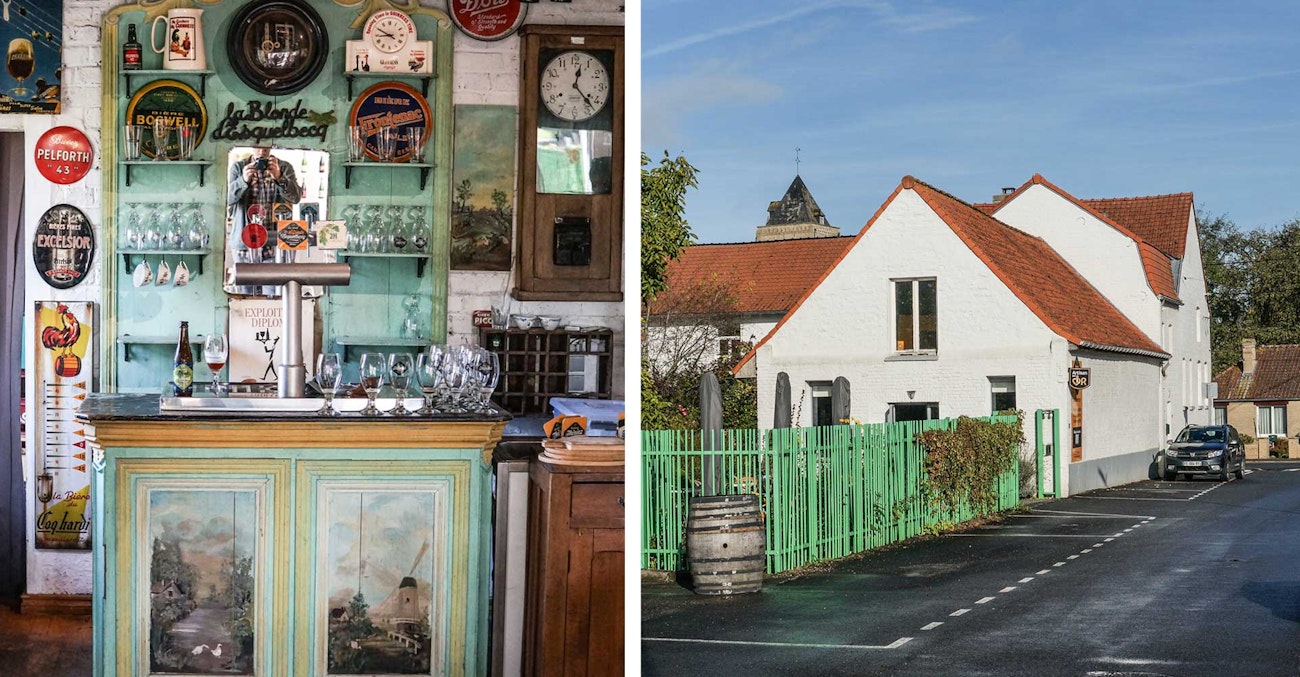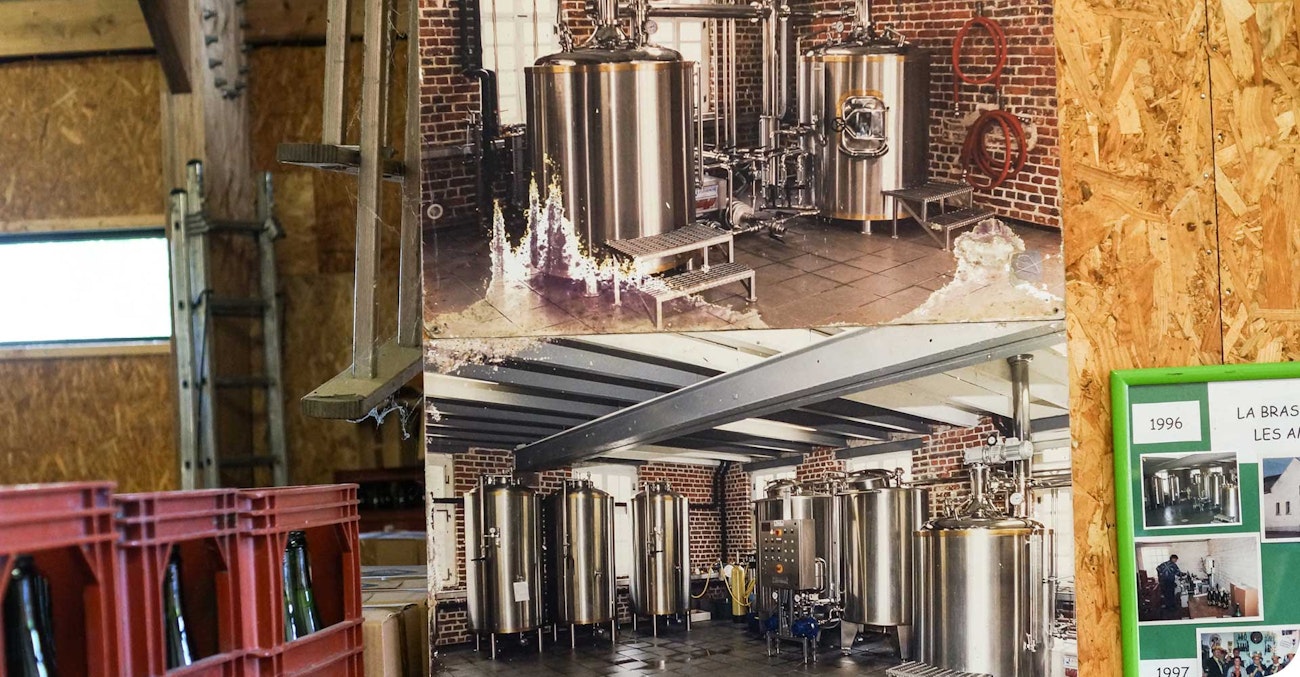I started the brewery in 1996. I was about 35 years old, and I had worked for more than 10 years for a big company in human resources. It was a good job, but I decided to change my life and start my own business. I wanted to be independent, to organize my lifestyle, and to make my own choices.
I visited a few breweries in Belgium. My wife is from Canada, so we also traveled to Canada and the northern United States quite frequently, and I could see that some very small breweries were starting. It was the beginning of the craft revolution, and I thought it was a great idea.
I’m originally from Lille, a big city in northern France. There was a very big brewing tradition here, but at the same time it was kind of a desert. There were very few breweries left; the bigger industrial breweries controlled everything. But I wanted to be in the countryside, using raw and simple ingredients to produce something sophisticated. If I’d been born in Bordeaux, I probably would have made wine instead of beer.
I was convinced that starting a brewery was a good idea, that artisanal brewing would come back, and that everything would be good for me. I was the only one—everybody else thought I was crazy. But my wife said, “Okay, if you think so, we’ll go and do this.” But it was difficult to explain to other people. They would say if I wanted beer, I should just go to the supermarket and buy it; there is plenty. But I told them, “Those are not my beers. What I want is not there.”
Inspiration from Wallonia
It took about two years to get it going—to study brewing, find and buy the property, and set up the brewery. I also needed to raise money—even for a small brewery—and I ended up buying the equipment from Italy. The equipment was brand new because there was no secondhand market at the time because there weren’t many small breweries.
Working on the recipes for my beers, the main inspiration came from a couple of Belgian breweries. The main one was Dupont, of course, but also Blaugies, and they were very kind to me. I thought their beers were absolutely great. In France, Brasserie Au Baron also was an inspiration.
I wanted to brew the beers that I like to drink. I was convinced that if I could brew a good beer to my tastes—drinkable, hoppy, complex—then other people would like it, too. Bitterness was not at all popular in our region in 1996; especially around here, people were more comfortable with Belgian tripel and other sweet, strong beers.
We started small and grew only slowly. I want to control the growth—I do not want to expand too much and brew for millions of people. I need to make only enough money to pay myself and, now, my seven employees.
After about three years, I started to construct a new building for the brewery. The original brewhouse was in an old part of our building, and it was on three different floors—not very convenient. We were also brewing daily, every week, to get enough beer out of our six-hectoliter (five-barrel) system. So, in 2006 I sold the smaller system and bought a 20-hectoliter system, one that is partly automatic. We still use this system today.

Photos: Ryan Pachmayer
The Origin of a House Strain
At first, it was very difficult to find yeast—there were very few homebrewers in France, and the Internet was just getting started, so there were no online shops. We could buy a few strains from Fermentis, and I would use S-04, but I quickly realized that I wanted a stronger yeast character.
So, I got in touch with the Institut Meurice in Brussels, a research college that specializes in chemistry and biochemistry—they have a lab there, and they also do brewery training. I took some training courses there, and I learned that they had a very large collection of hundreds of yeast strains.
The manager of the institute was very interested in my plans because there were so few small breweries at the time. He understood what kind of beers I wanted to brew, and he selected three yeast strains to try. I wanted good character, but I also wanted high attenuation and good flocculation. We brewed some wort on a small pilot-brewing system at the institute. We split the wort into thirds and fermented each portion with a different yeast strain.
I remember it very well, when my wife and I visited the office and sampled all three finished beers. We smelled all three beers, and we instantly knew which one we wanted. We tasted them, too, but we chose the yeast that would become our house yeast just by the nose. I’m still very happy with this yeast—I think it has the saison character, but it doesn’t dry out the beer too much, so it’s balanced. There is no sweetness left, but the fermentation does leave some body in the beer.
I have a contract for this yeast. They propagate it for me, and I visit every six months to pick it up. I am the only brewer using this particular yeast strain. I usually re-pitch for about 15 generations—it doesn’t change too much, but I think it’s best at around four or five generations. It starts a little slower at the beginning, but then gets a little faster.
Dispelling a Misconception
There are some “French saison” strains that people associate with my brewery. I do not know exactly how that happened. I first heard about it from the team at Jester King in Austin; they were the first to tell me that there were commercially available versions of the yeast that I use. However, none of the yeast labs contacted me about it.
A few years ago, a homebrewer from northern Europe picked up fresh yeast from me and took it home, then brewed exactly the same recipe with my yeast and with Wyeast 3711 French Saison. I wasn’t surprised when the flavor was rather similar—but the big difference was attenuation. The Wyeast strain ferments drier. I’ve now brewed several times in the United States with brewers who call this yeast a “monster yeast.” The gravity goes down and down, almost to zero, which my yeast does not do. So, I don’t know whether the commercially available varieties were cultured from a bottle and mutated, or whether something else happened.
Another key difference is that my yeast strain ferments to a maximum of only about 8 percent ABV. It is not very alcohol-tolerant; it stops working and becomes inconsistent. So, maybe the yeast strains are cousins, but they are not the same.
On the other hand: Because of these commercial strains, many amateur and professional brewers have contacted me, asked questions, and visited the brewery. So, in a way, it’s been free advertising.
Brewing at Thiriez
For the first year we brewed only one beer, La Blonde d’Esquelbecq. It’s still our flagship today, accounting for about 40 percent of our total production. Our second beer, the Ambrée, started as a winter beer with an amber color, but with the same yeast.
The following year, I made a new beer, and I decided I’d stick with the same yeast. With only a few exceptions, my beers are fermented with that same yeast strain.
My strain has a wide temperature tolerance, able to ferment from 57°F (14°C) up to 86°F (30°C). I can even take it down to 54°F (12°C), but it gets slow. After many fermentations, I decided the best compromise was about 72°F (22°C). We usually chill the wort to 70°F (21°C), rack to the fermentor with the yeast, and let the temperature rise. It starts very quickly, within two to three hours.
With La Petite Princesse—our bière de table created in collaboration with Jester King—we decided to let the temperature free-rise on its own. Within 12 hours it was at 86°F (30°C). It attenuates a little more this way, but mostly it’s just a much faster fermentation. It takes only 48 hours, but this is a very low gravity beer. Fermenting at the higher fermentation gives you different flavors.
Once fermentation is complete, I cool it down to 54°F (12°C). I cool it very slowly because the yeast is still active, and I don’t want to stress it. I then keep the beer at that temperature for seven to 10 days before dropping to 39°F (4°C) for the last few days, to make sure that the yeast drops out and settles down very well before bottling. That last cooling step is one I adopted after brewing with Yvan De Baets at Brasserie de la Senne in Brussels. In the fermentor, the carbonation is about 1.25 volumes of CO2. In the bottle, however, it’s about 3.25 volumes, and in the keg it’s about 2.5 to 2.75 volumes.

The original six-hectoliter brewhouse.
Pepper, Hops, and Wine
My yeast strain has some peppery notes, and it also goes very well with peppers and peppery foods. There’s no rule about this—it’s not a science; it’s like cooking and testing. We have a beer called Pepper Trip that’s has been very successful—we’ve been shocked; we run out of it all the time. This is a strong saison (8 percent ABV) with three kinds of pepper: black pepper from India’s Malabar Coast, Kampot white pepper from Cambodia, and Voantsy wild pepper from Madagascar.
In the Blonde, I use Brewer’s Gold for the bittering—it’s an English variety, but ours is grown locally—then I use Czech Saaz for the aromatics. More and more, though, I try to use local hops that are increasingly grown here in France and in Belgium—especially organic hops.
These days, more people are interested in sampling and buy craft beers instead of only industrial beers. There are a lot of small breweries in France—currently more than 2,500. Today, people who would not have tried a new beer 20 years ago are willing to try dark beer, sour beer, dry-hopped IPA—all kinds of styles. Still, French beer drinkers are relatively conservative. So, while they are open to tasting different styles, they quickly go back to more traditional blondes, tripels, pilsners—the basic styles.
Of course, we’re a wine country. For young people—say, between 20 and 35—wine is kind of old-school. I think beer’s competition, so to speak, is not really with wine; it’s more with cocktails, which are very popular in the cities. Some beers get very expensive, especially if you go to Paris. For almost the same price, you can get a fun cocktail.
In northern France, everybody has a bottle of beer in the fridge or the cellar, so if a friend comes over, you always have beer somewhere. Up here, beer is for every day, unlike in southern France or Paris.

